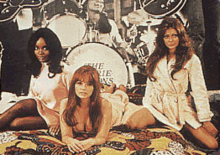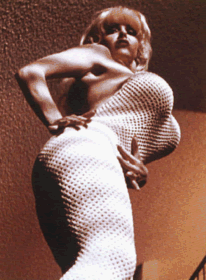 Their
original manager, Harris, has a fling with a glamorous erotic film star,
Ashley St. Ives, then falls into despair and winds up crippled after a
failed suicide attempt. The film climaxes with a grueling, jaw-dropping
Manson-style massacre that landed the film with an X rating which it never
managed to shed. Many familiar Meyer faces pop up along the way,
including Erica Gavin as a fashion industry lesbian, as well as Charles
Napier and Haji.
Their
original manager, Harris, has a fling with a glamorous erotic film star,
Ashley St. Ives, then falls into despair and winds up crippled after a
failed suicide attempt. The film climaxes with a grueling, jaw-dropping
Manson-style massacre that landed the film with an X rating which it never
managed to shed. Many familiar Meyer faces pop up along the way,
including Erica Gavin as a fashion industry lesbian, as well as Charles
Napier and Haji.  Henry
Rowland also makes the first of several appearances in his Martin Boorman
persona, this time as Z-Man's bartender, a smirking German on the sidelines.
Henry
Rowland also makes the first of several appearances in his Martin Boorman
persona, this time as Z-Man's bartender, a smirking German on the sidelines.
Obviously, the big studio switch was a shock. "It was like working in this massive metropolis," says Meyer. "I couldn't believe it would happen. I had no difficulty getting along with what the studio wanted because I was so hungry for this. If anybody had said we were doing something wrong, though, I probably would've picked up a pickax. Mostly they pretty much left me alone. I'd be doing hardcore pornography if it hadn't been for that one." Though the character of Ashley only appears in the first half of the film, she makes an unforgettable impression thanks to actress Edy Williams, who married Meyer after completion of the film. "When the film was starting, my character was named Ashley Famous, which is the name of the talent agency. Then the studio called and said we couldn't use the name, and we decided to call her Ashley St. Ives."
The most memorable figure in the film, though, is Z-Man himself, portrayed by John LaZar, an actor capable of spinning out Ebert's elaborate Shakespeare-laced dialogue while performing some of the wildest stuff imaginable. "What wild stuff?" LaZar laughs. "At the time, I was doing Caligula - the Camus play, not the Guccione movie. Fox was scouting for Tora! Tora! Tora!, and Phil Benjamin, the casting director, came backstage and said that he was with Fox. For once in my life, I shut my mouth, and to make a long story short, they brought me to the studio. I wound up getting blacklisted for that film. I'd walk in a casting agent's office and they'd say, 'You're not anything like that.' What do they work in, soap operas? I'm an actor. If I was really like that, I'd be in San Quentin!" According to Jim Ryan, some of Beyond's more outrageous footage actually wound up on the cutting room floor, including more of the infamous .45-swallowing scene and Ashley and Harris' break up on the beach. What remains, however, has made it a legend.
Meyer toiled over a decision for his next Fox effort. "Russ was offered several projects, including Edward Albee's A Year in the Garden," according to Williams. "He decided to do The Seven Minutes because of the trial aspect - a challenge." Based on an Irving Wallace novel, The Seven Minutes was criticized by the author for treating the theme of censorship too lightly, according to Ryan. The film involves an obscentiy trial of a young bookseller who distributed the title novel and a young lawyer's attempt to track down the original author. Some notable Hollywood faces like Yvonne DeCarlo and John Carradine make amusing appearances, and the film as a whole displays Meyer's finesse with dramatic timing and overlapping storylines. Though filled with the usual Meyer touches, The Seven Minutes failed to strike gold at the box office, wih Fox quickly slicing down the R-rated title into a much less effective PG version for general distribution. With any luck, Fox may someday issue the complete print on home video for fans to finally appreciate one of Meyer's most unjustly neglected films.
After a change in command at Fox, Meyer found himself ousted and decided to go back to independent filmmaking. He went to the island of Barbados for his only personally financed failure, Blacksnake! ("A film of violence born and nurtured by terror and climaxed with destructive retribution!"). An uneasy mixture of blaxploitation and S&M mania, the film caught on with neither audience, though Meyer explains Blacksnake! failed because "it didn't have any tits!" Meanwhile his marraige with Edy began to crumble; in her words, they were "pulled apart by media insanity and just would up going separate places."
Forced to start over from scratch, Meyer next embarked on a trilogy of films which represented his most extreme works as a filmmaker. In Supervixens, which Meyer asserts was designed as a live action cartoon, a series of increasingly humorous, violent vignettes accumulate around a man on the run and the murderous cop (Charles Napier again) who winds up crossing his path. Featuring a dynamic dual performance by the gorgous Shari Eubanks, the film is one of Russ' most popular later works, featuring an uproarious segment with Stuart Lancaster as a randy old farm owner and Uschi Digard as his mail order bride.
Supervixens is a carefree romp compared to its cinematic successor, Up!, which features the debut of Russ' female companion at the time, Francesca "Kitten" Natividad, as the dubbed narrator. Roger Ebert returned to pen the screenplay (under a pseudonym), which begins with Adolph Hitler (in hiding as Adolph Schwartz) being whipped by Candy Samples while paying the film's hero to sodomize him. Afterwards Adolph is devoured in his bath by a piranha, and a chain of murder and ugly revelations soon emerges. A controversial double rape sequence in a bar is hard to defend even for Meyer followers, and reaction to the film remains split down the middle. However, even detractors agree that the finale, in which two naked, knife-wielding beauties chase each other through a stream and spout plot-heavy dialogue, is one of Meyer's most inspired achievements. The film's star, Raven De La Croix (as Margo Winchester), has only fond memories of the production. "Everyone says that American films don't often have the depth of most foreign films, but if you look at Russ' films, he took themes through each of his films and created many, many layers. In the fashion he does it, there isn't this black and white linear experience. The way he handles female anatomy is really unlike anyone else and goes beyond where anyone else goes. It was a pleasure to have swung on trees and hung off cliffs and gotten dumped in streams; it was a wonderful boot camp for me, and I appreciated it."
In his last film to date, Meyer created
his most raucous, explicit comedy, Beneath the Valley of the Ultra-Vixens.  Again
written by Ebert, the frantic farce summarizes Meyer's themes and editing
style while presenting the buxom Kitten Natividad in the lead role.
As frustrated housewife Lavonia, Kitten tosses out her husband, who only
seems to be interested in, uh, rear entry, and poses as a Spanish-speaking
stripper, Lola Langusta ("hotter than a Mexican's lunch!"), to turn him
back around. Numerous silly subplots abound, with shots and scene
developments that make the most hyperactive cartoon look pokey in comparison.
Not a critical favorite, Ultra-Vixens is nevertheless a guaranteed
crowd pleaser and quite possibly its maker's funniest film. As the
film's Our Town narrator, Stuart Lancaster has never been better;
the fitting denouement finds him saluting Meyer, who trudges off into the
desert hills with his camera and equipment.
Again
written by Ebert, the frantic farce summarizes Meyer's themes and editing
style while presenting the buxom Kitten Natividad in the lead role.
As frustrated housewife Lavonia, Kitten tosses out her husband, who only
seems to be interested in, uh, rear entry, and poses as a Spanish-speaking
stripper, Lola Langusta ("hotter than a Mexican's lunch!"), to turn him
back around. Numerous silly subplots abound, with shots and scene
developments that make the most hyperactive cartoon look pokey in comparison.
Not a critical favorite, Ultra-Vixens is nevertheless a guaranteed
crowd pleaser and quite possibly its maker's funniest film. As the
film's Our Town narrator, Stuart Lancaster has never been better;
the fitting denouement finds him saluting Meyer, who trudges off into the
desert hills with his camera and equipment.
Looking back, Meyer has no apologies for his lifestyle and his cinematic approach. "The way it always goes with Russ Meyer is you've got to have a lot of good luck and a lot of very professional people who wish to accomplish something. Oftentimes I suppose [outsiders] would look at me somewhat askance: is he mad, or is he just someone trying to make a buck?" Though he hasn't directed a film since 1979, Meyer's reputation continues to grow thanks to new audiences discovering his work on a daily basis. His themes and motifs, including strong social statements and recurring characters, have established him as an American original who traveled beyond the barriers of erotic filmmaking and established a filmic world completely his own. Whether presenting a silly, sexy comedy or a stark, heartfelt drama, Meyer's characters continuously seem to be inhabiting different areas of the same creator's landscape, a territory populated with individuals as fascinating and astonishing now as when they first appeared larger than life (in every way) up on the big screen.










